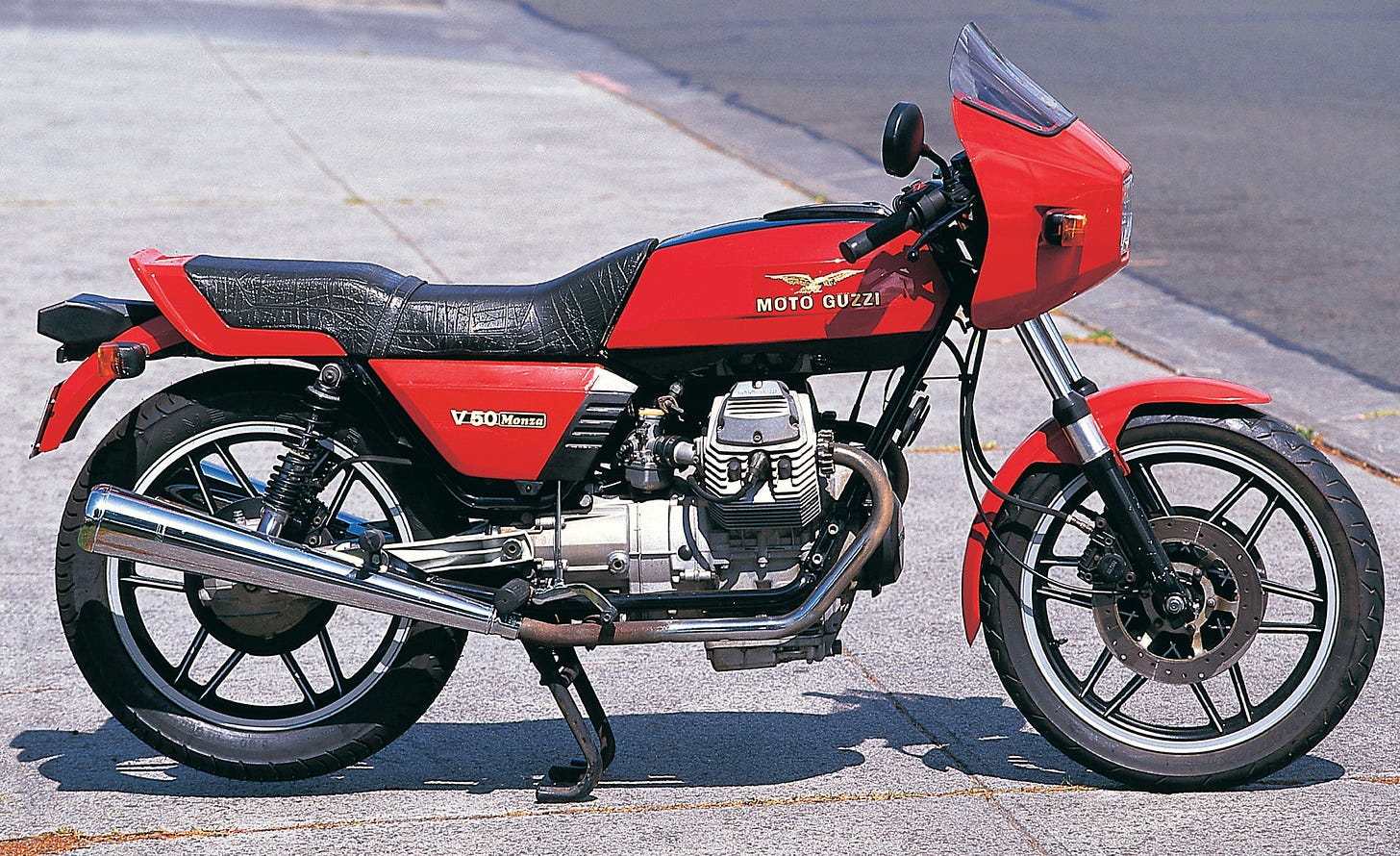The Argentinean entrepreneur Alejandro De Tomaso bought the ailing Moto Guzzi company at the end of 1972, but his idea was to build re-badged Benellis rather than Moto Guzzi’s traditional V-Twins. Soon after taking control of the company De Tomaso was reported to have strolled through the V7 assembly lines brandishing an engraved Arab sword, exclaiming “no more stupid twins”. Fortunately the success of the V7 Sport prompted De Tomaso to reconsider these views, eventually leading to a revitalised V-twin range. While some Benellis were rebadged as Moto Guzzis, these never really formed the core of the Moto Guzzi line-up during the 1970s and 1980s.
During the mid-1970s, the oil crisis led to many motorcycle manufacturers expanding their middleweight range. Moto Guzzi was no exception, and their designer Lino Tonti decided to retain their traditional layout, a 90-degree V-twin with shaft final drive. He eventually persuaded De Tomaso to sanction a smaller V-twin, initially in capacities of 350 and 500cc, but was instructed to increase production, and reduce manufacturing costs. Tonti managed to create a brilliantly compact motorcycle. With its chain-driven central camshaft and pushrod-operated valves, the 90-degree V-twin closely followed the layout of the larger bikes but in many other respects the design was more innovative, incorporating several technical advances over the larger twins.
The new design solved some of the problems that had never been tackled on the V7, in particular the clutch and accessibility of the oil filter. The oil filter could be replaced without removing the sump, and the dry clutch was improved through the use of one friction plate and a diaphragm spring in place of multiple coil springs. This clutch design gave far fewer problems than that of the larger twins, with minimal spline wear and a smoother action. Another variation from the larger engines was the cylinder head design, utilising Herron heads with two parallel valves, the combustion chamber incorporated in the piston crown. While this enabled high compression ratios, excellent fuel economy, and simplified manufacturing, the small valves and sharply curved ports restricted ultimate breathing.
There were several other changes to the overall design of the smaller engine and drivetrain. As it was a intended to be produced in a variety of engine displacements, the helical primary gears lived in an intermediate housing between the engine and gearbox. The alloy swingarm pivoted on the rear of the five-speed gearbox in a manner similar to that of the 500cc V8 racer. The frame was similar to the big twins, with a detachable lower section, but with extremely skinny air-assisted forks and twin shock absorbers. There were triple integrated disc brakes in the usual Guzzi style. The angular styling and engine finning would eventually influence the larger twins and the overall result was a remarkably light and compact motorcycle.
Not unexpectedly, sporting versions of both the V35 and V50 followed soon after their release in 1977. Styled along the lines of the Le Mans, with a mall fairing, clip-on handlebars and rear-set footpegs, these were the V35 Imola, and V50 Monza, both named after race tracks in Italy. The Monza had a considerably uprated engine over the regular V50. Retaining the engine dimensions of 75 x 57mm, there were larger valves and Dell’Orto PHBH 28B carburettors to see the power increased to 48bhp at 7600rpm. The sizes of all the gearbox shafts, gears and bearings were increased to cope with the power, and there was dual points ignition plus a duplex timing chain.
While the V50 Monza provided significantly improved performance over the V50, it was still no match for the other sporting 500s appearing at that time. Where the V50 Monza really scored was in its weight and dimensions. With a 1420mm wheelbase and weighing only 160kg, the bike was tiny – especially compared to the Honda CX500 “Plastic Maggot”. The quest for more power culminated in the introduction of a four-valve cylinder head on the 650cc Lario of 1984, but this lost the fine looks and balance of the V50 Monza. The small twin eventually grew to 750cc, and continues today as an 850 with more conventional hemispherical cylinder heads.
Most production of the smaller twins was not at the Moto Guzzi works at Mandello del Lario, but at the Benelli factory at Pesaro. The engines were built by Innocenti in Milan, with the frames by Maserati at Modena. Unfortunately this quest for cheaper manufacturing compromised the production quality of the smaller twins and the V50 Monza was largely forgotten. Providing an elegance and simplicity rare in the early 1980s, it never received the accolades it deserved despite offering a wonderful motorcycling experience away from the world of excessive weight and power.
Many thanks to subscriber Steve Zack for supplying some of the photos to accompany this article.









Beautiful bike, Steve!